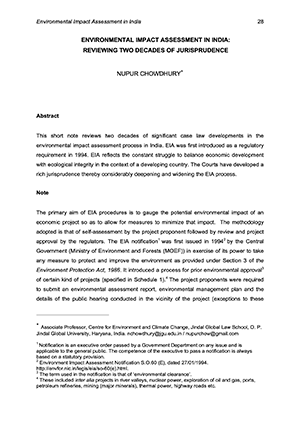Environmental Impact Assessment in India: Reviewing Two Decades of Jurisprudence
This short note reviews two decades of significant case law developments in the environmental impact assessment process in India. Environmental Impact Assessment (EIA) was first introduced as a regulatory requirement in 1994. EIA reflects the constant struggle to balance economic development with ecological integrity in the context of a developing country. The Courts have developed a rich jurisprudence thereby considerably deepening and widening the EIA process.
The primary aim of EIA procedures is to gauge the potential environmental impact of an economic project so as to allow for measures to minimize that impact. The methodology adopted is that of self-assessment by the project proponent followed by review and project approval by the regulators. The EIA notification was first issued in 1942 by the Central Government (Ministry of Environment and Forests (MOEF)) in exercise of its power to take any measure to protect and improve the environment as provided under Section 3 of the Environment Protection Act, 1986. It introduced a process for prior environmental approval of certain kind of projects. The project proponents were required to submit an environmental assessment report, environmental management plan and the details of the public hearing conducted in the vicinity of the project (exceptions to these requirements were permitted for certain projects). The MOEF would function as Impact Assessment Agency which could consult a Committee of Experts set up for this purpose.
